|
|
Heather Species
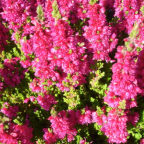
|
Calluna vulgaris (Scotch or Ling Heather)
These plants are the most varied and interesting of all heather. Leaves are small and scale like. Flowers are single or double. Their forms vary from small tuffs to shrubs over two feet tall. Most are small bushes to 36 inches. Foliage color can be as beautiful as the flowers with golds, oranges, gray and many shades of green. These colors change with cold weather to red, orange, bronze and the dark green taking on plum tints. Some of the varieties have beautiful colors of new growth, with shades of pink, yellow, orange and cream. These heather do best in well drained, acid soil. They need sun for at least half the day for their best color. Callunas must be pruned or they will become leggy. Trim to below the old flowers in late fall or early spring. Zone 4 and warmer.
|
Daboecia cantabrica (St. Dabeoc’s Heath)
Dark green, shiny upright evergreen leaves, white underneath. Flowers ½” long and egg shaped. Blooms May – October. Prefers to grow in moist, well-drained peaty soils. Prune plant below old flowers in late fall or early spring. Zone 6 and warmer.
|
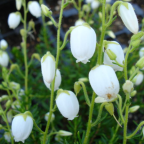
|
|
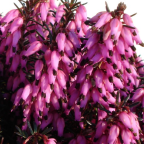 |
Erica carnea (Winter Heath)
Needle-like foliage. Native to mountains of central and southern Europe. Flowers during period from October to April. Low and fast growing, well suited to be a ground cover. Forms a weed-smothering mat. Light shearing when the plant is young will form dense growth. This will help prevent the plant from forming bare wood in the center. Slightly acid to alkaline soils. Very hardy. Zone 4 and warmer.
|
Erica cineria (Bell Heather)
Leaves are short needles in bundles. Stiff branches, upright to 24 inches. Blooms early summer from May-September. Flower colors are some of the brightest and most vivid of all heather. Prune below old flowers in early spring. Prefers well-drained acid soil. Zone 5 and warmer.
|
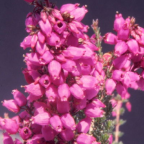 |
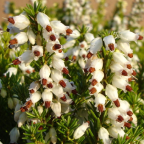 |
Erica erigina (Irish Heath)
These heath bloom from November to May as the winter heath are finishing but before the summer varieties start. They have a dense bushy upright habit. Their height range is from 4 feet to 12 feet for taller varieties. The foliage is somewhat brittle and may be damaged by heavy snow cover. They grow in a wide range of soils and are found in bog areas in Ireland. Flowers have a honey fragrance. Zone 7 and warmer.
|
Erica vagans (Cornish Heath)
Plants grow symmetrically and make attractive hummocks. In the inflorescence the lower flowers fade and change to russet brown before the top blooms open. It grows low and spreading, making it a good ground cover. It grows naturally in neutral or slightly alkaline soils. It also does well in moderately acid soils and heavy soils. Zone 5 and warmer.
|
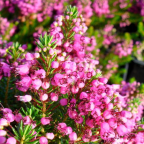 |
|
|
Erica tetralix (Crossed Leaf Heath)
Plants are named for their leaves which are arranged in a whorl of four forming a cross. As a variety they have gray-green foliage and bloom from May to October. Plants prefer acid soil and are found growing naturally in boggy areas but will tolerate drier conditions. Very hardy to zone 4 and warmer.
|
Erica x darlyensis
A hybrid of Erica carnea and Erica erigenia. Winter flowering with bright colored flowers blooming through winter months to May. Flowers open pale and then brighten as the season progresses. Leaves have pink or cream tips in spring. This plant is bushier then Erica carnea and grows to 1½ to 3 feet tall. Light shearing when plant is young is good. Prune to shape soon after blooming. Slightly acid to alkaline soils. Zone 5 and warmer.
|
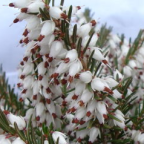 |
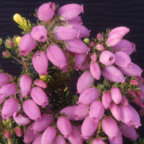 |
Erica x stuartii (Stuart’s Heath)
A Natural hybrid between Erica mackaiana and Erica tetralix. The plant is native to Western Ireland. New growth is very showy with yellow and orange tips. These plants have a long blooming season, from May to October. Prefers acid soil. Zone 5 and warmer.
|
Erica x watsonii (Watson’s Heath)
A group of natural hybrids from Erica ciliaris and Erica tetralix first found in Turno Cornwall, England. Very soft foliage with colored tips on new growth in spring. Long flowering season with bottle shaped flowers. Acid, well-drained soil. Zone 5 and warmer.
|
|
|
|
Erica x williamsii (William’s Heath)
A natural hybrid between E. vagans and E. tetralix. The two varieties were found growing on the Lizard Peninsula in Cornwall. Beautiful foliage and good flowers borne in short clusters. A quick spreading ground cover. Soil must be lime free but does well in heavy soil. Zone 5 and warmer.
|
|

